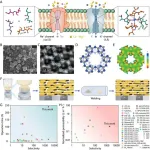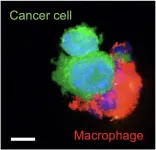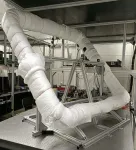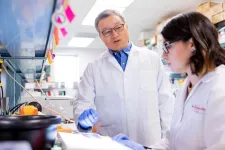(Press-News.org) SAN ANTONIO, June 14, 2024 – The University of Texas Health Science Center at San Antonio School of Dentistry is preparing to launch its Center for Regenerative Sciences, a new research initiative that aims to position the university at the forefront of regenerative dentistry and medicine.
“The center will provide new avenues for interdisciplinary collaborations to accelerate the translation of preclinical discoveries into therapeutic benefit for patients suffering from dental, oral and craniofacial diseases,” said Yong-Hee Chun, DDS, PhD, MS, associate professor of periodontics at the UT Health San Antonio School of Dentistry.
Chun’s research focuses on understanding the molecules essential for tooth development and mineralization. “When teeth and their support structures are malformed, such as with molar-incisor hypomineralization, or are damaged by diseases like periodontal disease, new treatments are needed. These treatments aim to regenerate the affected tissues and restore normal function,” she said.
Anibal Diogenes, DDS, PhD, professor and chair of the Department of Endodontics, also highlighted the center’s potential.
“We have the capability to advance the field rapidly due to our ability to translate biological advancements into clinical applications faster than many other medical fields,” he said. “This center represents a huge opportunity to bootstrap the field, diversify our research and enhance collaboration among our scientists.”
The Center for Regenerative Sciences will focus on several key areas, including the development of advanced tissue regeneration strategies, 3D printing of tissues and acellular scaffolds, the encapsulation of growth factors, morphogens and chemotactic molecules for targeted drug delivery.
“Our goal is to create an environment within the body where biological cues guide cells to achieve their full potential,” Diogenes said. “By integrating basic sciences with clinical applications, we can bridge gaps and push the field of regenerative dentistry forward.”
The center intends to accomplish this by leveraging and expanding the school’s existing strengths in regenerative endodontics, dental and craniofacial development and the advancement of reliable sources of potent stem cells.
Diogenes’ research, for example, includes work on stem cell-based root canal therapies for children.
“When a child’s dental pulp is damaged or infected, we can activate their own stem cells to reestablish the pulp and allow the tooth to continue developing, which is crucial for their overall growth and development,” he noted. “This has significant implications not only for a child’s dental health but also for their nutrition, speech development and psychosocial well-being.”
Brij B. Singh, PhD, associate dean of research at the school, spoke to the broader impact of the new center.
“This initiative will not only enhance our research capabilities but will attract top talent from various fields, creating a collaborative environment that can lead to breakthroughs in both dental and medical sciences,” he said. “The vision is to become a global leader in regenerative sciences, ultimately improving patient care outcomes everywhere.”
UT Health San Antonio is the largest academic research institution in South Texas with an annual research portfolio of $413 million.
“The body has amazing regenerative capacity and the oral cavity is very special,” Diogenes said. “It’s very rich in stem cells that are extremely potent with a high regenerative capacity. They are also unique because oral stem cells come from an origin where they can even become neurons. This means they have the potential to be used as therapies in many neurodegenerative diseases such as Alzheimer’s or Parkinson’s therapies and for spinal cord injuries. There is so much potential there that extends far beyond the oral and craniofacial structures.”
The Center for Regenerative Sciences will be formally launched by the school later this fall. It will be one of three centers of dental research, joining the Center for Global and Community Oral Health and the Center for Pain Therapeutics and Addiction Research. Recruitment for the center’s director is currently underway.
For more information, visit the UT Health San Antonio School of Dentistry’s website.
The University of Texas Health Science Center at San Antonio (UT Health San Antonio), a primary driver of San Antonio’s $44.1 billion health care and biosciences sector, is the largest academic research institution in South Texas with an annual research portfolio of $413 million. Driving substantial economic impact with its six professional schools, a diverse workforce of more than 8,500, an annual expense budget of $1.46 billion and clinical practices that provide 2.6 million patient visits each year, UT Health San Antonio plans to add more than 1,500 higher-wage jobs over the next five years to serve San Antonio, Bexar County and South Texas. To learn about the many ways “We make lives better®,” visit UTHealthSA.org.
The UT Health San Antonio School of Dentistry offers 18 degrees and programs in both dentistry and dental hygiene, world-renown faculty educators, a diverse student population, state-of-the-art clinical facilities and a distinguished research enterprise. Departments include comprehensive dentistry, developmental dentistry, endodontics, periodontics, and oral and maxillofacial surgery. Scientists collaborate with clinicians and research teams worldwide, and work across multiple medical and dental disciplines to find new treatments, advancing knowledge of oral health, biomaterials, cancer, pain and more. To learn more, visit https://www.uthscsa.edu/academics/dental.
Stay connected with The University of Texas Health Science Center at San Antonio on Facebook, Twitter, LinkedIn, Instagram and YouTube.
Share This Article!
FacebookTwitterEmailLinkedIn
END
UT Health San Antonio School of Dentistry to launch new Center for Regenerative Sciences
2024-06-14
ELSE PRESS RELEASES FROM THIS DATE:
New carbon nitride membrane revolutionizes lithium extraction from salt lakes
2024-06-14
In a major breakthrough for lithium recovery technologies, researchers from the Qingdao Institute of Bioenergy and Bioprocess Technology (QIBEBT) of the Chinese Academy of Sciences, together with collaborators, have developed a crystalline carbon nitride membrane that could transform the lithium extraction industry.
The innovative design, which mimics biological ion channels, shows remarkable efficiency and durability in separating lithium ions from magnesium ions in salt-lake brine.
The study, published in Science Advances on June 14, introduces a ...
Nano-immunotherapy developed to improve lung cancer treatment
2024-06-14
KEY TAKEAWAYS
Lung cancer is the most diagnosed cancer and the leading cause of cancer death globally, representing an urgent need for new and improved treatment options.
Researchers from Brigham and Women’s Hospital developed a new nanomedicine therapy that delivers anticancer drugs to lung cancer cells and enhances the immune system's ability to fight cancer.
The research must undergo rigorous toxicology studies before moving into clinical testing in patients but represents a potential treatment for patients who have failed to respond to traditional immunotherapy.
Researchers at Brigham and ...
Upper surface of coastal waters can accumulate bacteria and antibiotics
2024-06-14
Atlanta, GA – June 14, 2024 – Antibiotics in the uppermost water surface, known as the sea surface microlayer, can significantly affect the number of bacteria present and contribute to the adaptation of marine bacteria against widely used antibiotics. In new research presented at ASM Microbe, scientists directly assessed the potential effects of antibiotics on bacterial diversity in Jade Bay, Southern North Sea, Germany.
The researchers tested the susceptibility and resistance of marine bacteria to ofloxacin, ...
AI enables faster, more effective antibiotic treatment of sepsis
2024-06-14
Atlanta, GA—Sepsis is a life-threatening infection complication and accounts for 1.7 million hospitalizations and 350,000 deaths annually in the U.S. Fast and accurate diagnosis is critical, as mortality risk increases up to 8% every hour without effective treatment. However, the current diagnostic standard is reliant on culture growth, which typically takes 2-3 days. Doctors may choose to administer broad-spectrum antibiotics until more information is available for an accurate diagnosis, but these can have limited efficacy and potential toxicity to the patient.
In a study presented at ASM Microbe, a team from Day Zero Diagnostics unveiled a novel approach to antimicrobial susceptibility ...
Quantum entanglement measures Earth rotation
2024-06-14
A team of researchers led by Philip Walther at the University of Vienna carried out a pioneering experiment where they measured the effect of the rotation of Earth on quantum entangled photons. The work, just published in Science Advances, represents a significant achievement that pushes the boundaries of rotation sensitivity in entanglement-based sensors, potentially setting the stage for further exploration at the intersection between quantum mechanics and general relativity.
Optical Sagnac interferometers are the most sensitive devices to rotations. They have been pivotal in our understanding of fundamental physics since the early years of the last century, contributing to establish ...
New rapid detection of bacteria in pediatric blood samples
2024-06-14
Atlanta, Ga. – June 14, 2023 – Researchers have demonstrated that a new technology could quickly and accurately diagnose bloodstream infections. The study findings were reported at ASM Microbe, the annual meeting of the American Society for Microbiology.
“There is a need to be able to rapidly and accurately diagnose bacteremia in newborn babies. They are especially susceptible to long-term morbidities and mortality the longer they go without treatment, or even with inaccurate treatment for bloodstream infections or sepsis,” said presenting study author April Aralar, Ph.D., a ...
Ex vivo gene editing and cell therapy for hereditary tyrosinemia type 1
2024-06-14
Background: We previously demonstrated the successful use of in vivo CRISPR gene editing to delete 4-hydroxyphenylpyruvate dioxygenase (HPD) to rescue mice deficient in fumarylacetoacetate hydrolase (FAH), a disorder known as hereditary tyrosinemia type 1 (HT1). The aim of this study was to develop an ex vivo gene-editing protocol and apply it as a cell therapy for HT1.
Methods: We isolated hepatocytes from wild-type (C57BL/6J) and Fah-/- mice and then used an optimized electroporation protocol to deliver Hpd-targeting CRISPR-Cas9 ribonucleoproteins into hepatocytes. Next, hepatocytes were transiently incubated in ...
Intranasal COVID-19 vaccine headed to clinical trials
2024-06-14
University of Georgia-based startup CyanVac LLC received federal funding to support a comparative Phase 2b clinical trial of CVXGA, the company’s intranasal vaccine candidates designed to protect against COVID-19.
As part of the award from Project NextGen, a federal initiative based in the U.S. Department of Health and Human Services (HHS), CyanVac will sponsor a randomized, double-blind Phase 2b study with 10,000 participants to compare the efficacy and safety of the intranasal vaccine against an FDA-approved mRNA-based COVID-19 vaccine.
The new vaccine is based on a viral delivery platform developed by He containing modified ...
High out-of-pocket costs may be barrier to filling naloxone prescriptions, study shows
2024-06-14
Patients are less likely to fill prescriptions for naloxone when they face increases in out-of-pocket costs, according to U-M researchers.
Patients are less likely to fill prescriptions for naloxone when they face increases in out-of-pocket costs, according to research by the University of Michigan.
Published in the Journal of the American Medical Association, the study utilized data from a national pharmacy transactions database from November 2020 to March 2021. Researchers found that about 1 in 3 naloxone ...
Sharks have depleted functional diversity compared to the last 66 million years
2024-06-14
New research by Swansea University and the University of Zurich has found that sharks retained high levels of functional diversity for most of the last 66 million years, before steadily declining over the last 10 million years to its lowest value in the present day.
Modern sharks are among the ocean’s most threatened species; yet have notably survived numerous environmental changes in their 250-million-year history. Today, their more than 500 species play many different ecological roles, from apex predators to nutrient transporters.
Ecological roles are determined by species’ traits such as body size, ...



